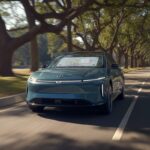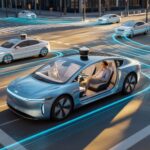
Extended Range EVs: A New Era of Electric Mobility
Introduction
The electric vehicle (EV) market has witnessed significant growth in recent years, driven by technological advancements, environmental concerns, and government incentives.
A key factor driving this growth is the increasing range of EVs, with models now offering over 400 miles on a single charge.
This report delves into the emergence of extended range EVs, focusing on new models and the impact on consumer concerns related to range anxiety.
New Models: Pushing the Boundaries
The automotive industry is in a race to develop electric vehicles with extended ranges.
Several manufacturers have introduced models capable of traveling over 400 miles on a single charge.
- Tesla Model S Plaid: This high-performance electric sedan boasts impressive acceleration and a claimed range exceeding 400 miles.
- Lucid Air: Known for its luxurious interior and cutting-edge technology, the Lucid Air offers a range comparable to the Tesla Model S Plaid.
These vehicles represent a significant leap forward in EV technology, addressing one of the primary barriers to wider adoption.
The Impact on Range Anxiety
Range anxiety, the fear of running out of battery power before reaching a charging station, has been a major obstacle to EV adoption.
The emergence of extended range EVs has significantly alleviated this concern for many consumers.
- Increased Confidence: By offering longer ranges, these vehicles provide drivers with greater confidence for longer journeys, reducing the need for careful route planning.
- Expanded Market: The availability of extended range EVs is expected to attract a wider range of consumers, including those who previously considered EVs impractical for their lifestyle.
- Charging Infrastructure: While range anxiety is mitigated, the continued expansion of charging infrastructure remains crucial to support the growing number of EVs on the road.
Factors Contributing to Extended Range
Several factors have contributed to the development of extended range EVs:
- Battery Technology: Advancements in battery chemistry and cell density have enabled higher energy storage capacity without compromising size or weight.
- Aerodynamics: Improved vehicle aerodynamics reduce energy consumption, allowing for increased range.
- Energy Efficiency: Optimized powertrain components and energy management systems contribute to maximizing range.
Challenges and Future Outlook
Despite the progress made, challenges remain in the development of extended range EVs:
- Battery Costs: The high cost of batteries continues to impact the overall price of EVs.
- Charging Infrastructure: While improving, the availability of high-speed charging stations is still uneven in many regions.
- Battery Degradation: Over time, battery capacity tends to decline, potentially affecting the vehicle’s range.
The future of electric vehicles is bright, with ongoing research and development focused on further increasing range, reducing costs, and improving charging infrastructure.
As battery technology advances and charging networks expand, we can expect to see even more impressive range figures from new EV models.
Conclusion
The introduction of extended range EVs marks a significant milestone in the electric vehicle industry.
By addressing range anxiety, these vehicles are accelerating the adoption of electric mobility.
Continued advancements in battery technology, charging infrastructure, and vehicle design will further enhance the appeal of EVs and contribute to a sustainable transportation future.
A Comparison of Long-Range Electric Vehicles
The electric vehicle market has rapidly evolved, with an increasing number of models offering impressive ranges.
Here’s a comparison of some of the leading contenders:
Key Factors for Comparison
- Range: The primary focus of this comparison.
- Price: Starting MSRP.
- Charging Speed: DC fast charging capability.
- Performance: Acceleration, handling, and power output.
- Interior and Exterior: Design, comfort, and features.
Top Contenders
Note: The EV market is dynamic, with new models and updates being released frequently.
It’s essential to check the latest specifications and pricing from official sources.
| Model | Range (EPA) | Starting MSRP | Charging Speed | Performance | Interior/Exterior |
|---|---|---|---|---|---|
| Tesla Model S Plaid | 396 miles | $104,990 | Up to 250 kW | High performance | Luxurious, minimalist |
| Lucid Air | 516 miles | $87,400 | Up to 195 kW | High performance, luxury | Spacious, modern |
| Rivian R1T | 314 miles (largest battery pack) | $72,800 | Up to 200 kW | Off-road capability, spacious | Adventurous, technology-focused |
| Ford F-150 Lightning | 320 miles (extended range) | $63,974 | Up to 150 kW | Powerful, truck capabilities | Spacious, practical |
| Hyundai Ioniq 5 | 303 miles | $40,900 | Up to 350 kW | Good performance, practical | Modern, tech-focused |
Additional Considerations
- Battery Warranty: The length of the battery warranty can impact long-term ownership costs.
- Charging Network Access: Consider the availability of charging stations for your specific needs.
- Vehicle Size and Type: Choose a vehicle that suits your lifestyle and family size.
- Government Incentives: Take advantage of available tax credits or rebates.
Conclusion
The choice of a long-range electric vehicle depends on individual preferences and priorities.
Factors such as desired range, budget, driving style, and charging infrastructure should be carefully considered.
As the EV market continues to expand, consumers can expect even more options and advancements in technology.


